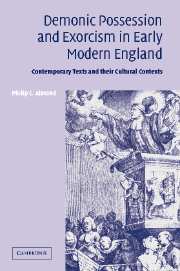 Demonic Possession and Exorcism in Early Modern England
Demonic Possession and Exorcism in Early Modern England Published online by Cambridge University Press: 22 September 2009
In April 1593, Alice Samuel, her daughter Agnes, and her husband John were hanged for witchcraft. They had been convicted of the bewitching of the five daughters of Robert Throckmorton of Warboys, and the bewitching to death of Lady Cromwell, second wife of Sir Henry Cromwell of Hinchinbrook. After the deaths of the Samuels, the text informs us in its concluding paragraph, none of the bewitched children manifested any signs of possession. ‘But they have all of them been in as good a state and as perfect health as ever from their birth.’ This was the first well-known case in England of accusations of bewitchment by possessed girls leading to the deaths of those accused.
For the previous three and a half years, the Throckmorton children had shown all of the signs of the possessed. Around 10 November 1589, Jane, ten years of age and the second youngest of the five girls, began to exhibit convulsions and a trance. Within two months, all the sisters, ranging in age from nine to fifteen years, were having violent fits from several to many times a day, of which they later claimed to have no memory. The oldest girl Joan predicted that twelve people in total would be bewitched, herself and her five sisters, and seven female servants. And thus it happened. When the servants were sent away they recovered, but their replacements became similarly afflicted.
To save this book to your Kindle, first ensure no-reply@cambridge.org is added to your Approved Personal Document E-mail List under your Personal Document Settings on the Manage Your Content and Devices page of your Amazon account. Then enter the ‘name’ part of your Kindle email address below. Find out more about saving to your Kindle.
Note you can select to save to either the @free.kindle.com or @kindle.com variations. ‘@free.kindle.com’ emails are free but can only be saved to your device when it is connected to wi-fi. ‘@kindle.com’ emails can be delivered even when you are not connected to wi-fi, but note that service fees apply.
Find out more about the Kindle Personal Document Service.
To save content items to your account, please confirm that you agree to abide by our usage policies. If this is the first time you use this feature, you will be asked to authorise Cambridge Core to connect with your account. Find out more about saving content to Dropbox.
To save content items to your account, please confirm that you agree to abide by our usage policies. If this is the first time you use this feature, you will be asked to authorise Cambridge Core to connect with your account. Find out more about saving content to Google Drive.